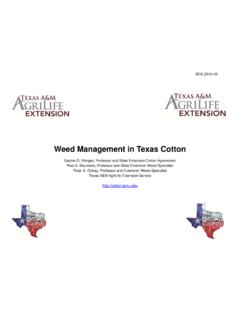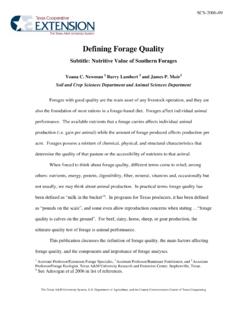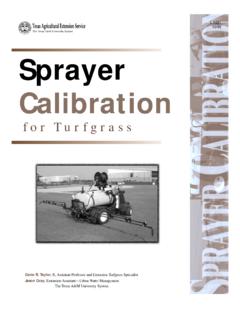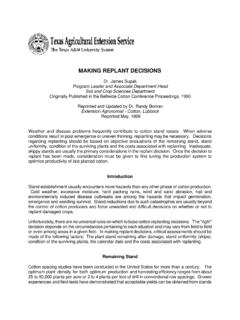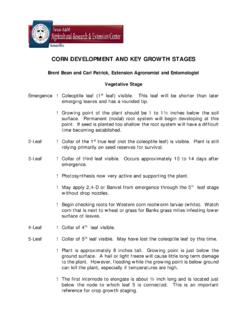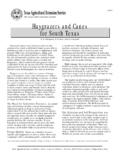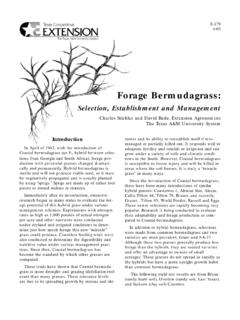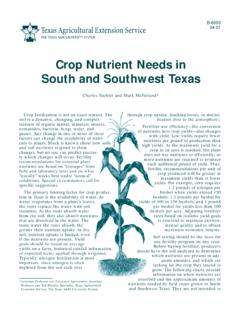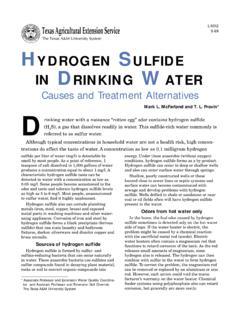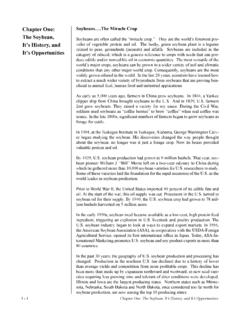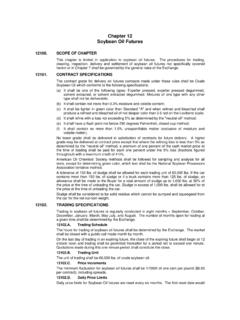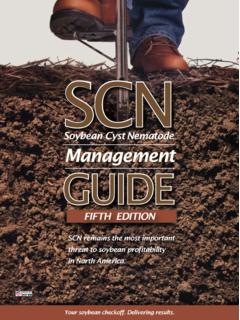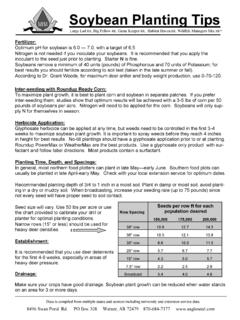Transcription of Quick Guide for Soybean Production in the Texas …
1 SCS-1998-22. Texas Agricultural Extension Service The Texas A&M University System Quick Guide for Soybean Production in the Texas Panhandle and South Plains Brent Bean and Travis Miller Associate Professor and Extension Agronomist, Amarillo Professor and Extension Agronomist, College Station Soybean Variety Classification 3 Yield advantage for early planting of inde- terminate varieties. 3 Indeterminate - Plants bloom and produce pods while still growing vegetative plant 3 If a determinate variety is planted too late parts. Group 00 - IV soybeans are mostly pods may develop close to the ground, this type. making harvest difficult. 3 Determinate - Plants finish vegetative Variety Selection growth, then go to reproductive stage.
2 Group V - VIII soybeans are mostly this 3 Will depend on planting date. A group IV. type. bean generally works the best. However, group III or V beans can be considered. Lots 3 More than of soybeans in Texas are of variability in Group IV class (as much as Group IV (primarily indeterminate). 25 days in maturity). Planting 3 Plant soybeans with different maturity lengths when planting large acreage. This 3 Planting date ranges from May 15 to July 1, will help with harvest. depending on the variety. 3 Consider water availability (shorter maturing varieties will require less water). 3 Rate 120,000-130,000 seed/acre (approxi- mately 56 lbs of seed per acre depending on 3 Make sure variety is adapted to this area. seed size). Row Spacing 3 If planting with a drill, increase seeding rate to 150,000-190,000 seed/acre.
3 3 Narrow rows promote quicker canopy for- mation. 3 Seeding rate more critical on indeterminate non-branching varieties. 3 Branching type bean (bushy) will aid in canopy formation on wide rows. 3 Soil temp 600 is optimum. Germination will occur at 52-530 - but slow. 3 Multiple rows/bed is option. 3 Early planting seldom an advantage for The information given herein is for educational purposes only. Refer- determinate varieties. ence to commercial products or trade names is made with the under- standing that no discrimination is intended and no endorsement by the Texas Agricultural Extension Service is implied. Educational programs conducted by the Texas Agricultural Extension Service are open to all people without regard to race, color, sex, disability, age, or national origin.
4 Inoculum 3 Iron chlorosis may be problem in calcareous soils or high pH's. Best to choose a variety 3 Inoculum - Live bacteria; must take care of that can tolerate soils low in iron. it. Hot, dry conditions and sunlight will kill bacteria. If a foliar iron application is made, good coverage is essential. Usually one appli- 3 Takes 3-4 weeks for Soybean plant to begin cation is sufficient for beans to over fixing N. In some instances, soybeans may come iron deficiency. benefit from 15-20 lbs N applied at plant- ing. Irrigation 3 Must coat seed with inoculum. A sticker 3 Yield not limited with 20-24 inches of water such as Coke works well while also serving and a full profile at planting. as a sugar source for bacteria. 3 Water requirement will be somewhat depen- 3 Avoid Captan use because it injures bacte- dent on maturity length.
5 Ria. Try to avoid long-term exposure to other fungicides. 3 Greatest irrigation efficiency was of PET. at Halfway. 3 Granular inoculum costs more ($ ) but works well when put in seed furrow with 3 At Halfway, no difference between watering seed. interval of days to 14 days as long as adequate amount of water was applied. 3 Slurry mixes cost $ for 1 X rate. Critical Growth Stages 3 Consider 2X inoculum rate if land has not been planted to soybeans for a number of 3 Vary with plant growth habit - (indetermi- years. nate vs determinant). 3 Commercial liquid inoculums are available 3 Bloom that contains stickers. Only use 1X rate of this material to avoid over wetting the seed. 3 Seed fill Land Management 3 It takes approximately 35 days to go from bloom to mature seed.
6 Must keep wet 3 Must avoid plow plan, soybeans will utilize during this period. H2O from at least 5 ft. 3 Disease pressure is minimal on new Soybean Fertility Needs for 40 Bu. Bean/Acre land. Element Stubble Seed Total Harvest N 80 150 230. 3 Harvest at 13% moisture. Soybeans split P2O 5 20 35 55 and shatter as moisture drops below 10%. K 2O 50 55 105 3 Reduce cylinder speeds to 450 to 500 rpm, slightly higher on high moisture soybeans. Mg 15 7 22. 3 Reduce field speeds to 3 mph. S 10 4 14. 3 Evaluate harvest loss when setting combine. Zn Four beans per square foot is equal to one bushel/acre.

